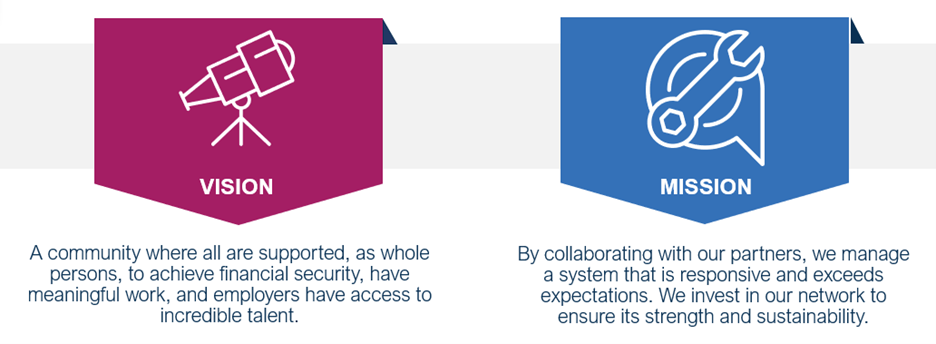Municipal Approach to Employment Service System
A Municipal Approach To Employment Service System Leadership
By Aaron Stauch
March 2023

In February 2019, the Ontario government announced its plan to transform the province’s employment services, with the goal of making these services more efficient, more streamlined, and outcomes focused. The vision of Employment Services Transformation (EST) is to build a locally responsive employment services system that effectively meets the needs of a diverse range of job seekers and employers in Ontario. In 2020, the implementation of EST began in three prototype regions of Peel, Hamilton Niagara, and Muskoka-Kawarthas.
On June 10, 2021, the expansion of EST to nine additional catchment areas, including the Stratford-Bruce Peninsula, was announced, along with a two-stage competitive process for the selection of Service System Manager (SSMs) in these areas. Bruce County (lead), Grey County, Huron County, and the City of Stratford formed a consortium, as approved by councils, to respond to the Request for Qualification and submitted a response to a Call for Proposals. The consortium was awarded the SSM role for the Stratford-Bruce Peninsula in April 2022.
Through this application Directors and staff from human services from each member municipality collaborated to develop an application that would see the Service System Manager focus on improving the integration of Ontario Works, ODSP, local employment services providers, and the needs of local employers. Working together across traditional silos, the consortium will support the creation of an integrated human services model that does not leave people behind.
The Employment Service System Manager for the Stratford-Bruce Peninsula took a truly local approach to service system management. Within the Employment Service Transformation, the Bruce, Grey, Huron, and Stratford consortium is the only Service System Manager that formally brought together the four CMSMs into an integrated model to deliver employment services to the catchment area. To date the SSM has undertaken the following work in establishing the SSM:
- Establishing a Governance Structure: The SSM setup a governance structure focused on the integration of human service and economic development, and the SSMs ability to engage the community in the development of services. This included:
- Executive Steering Committee (ESC): The Committee is comprised of the Directors responsible for Social Assistance and Economic Development for each of the member municipalities. This committee is responsible for strategic direction for the SSM.
- Regional Advisory Committee (RAC): The Committee is comprised of the Directors of Human Services, and Planning and Development from Bruce County; a senior staff person from each member municipality; the Director of Economic Development for Perth County; the Regional Employment Services Manager; the Executive Director (or delegate) from each employment service provider in the SSM; a labour market information provider; a literacy provider; a youth service provider; and disability service provider; a settlement service provider, the Ontario Disability Employment Network, an Indigenous service provider, and a Francophone Service Provider. This committee is responsible for providing advice to support the successful implementation of the SSM.
- Employment Service Implementation Team (ESIT): This committee is comprised of the manager responsible for Ontario Works from each member municipality, the Senior Manager for the Ontario Disability Support Program offices in the catchment, an Ontario Disability Support Program Manager, and SSM staff. This committee is responsible for integration of Social Assistance and Employment Services.
- Service Provider Network: This committee is comprised of the senior staff member of each employment service provider. This committee is responsible for the co-design of future state employment services.
Over the Fall 2022, the SSM has been engaged in a process to assess the current performance of the employment system in the catchment area and develop the strategy to strengthen the system starting in April 2023. Through this strategic planning experience, the SSM engaged community partners through the Executive Steering Committee, Service Provider Network, and Regional Advisory Committee to co-design the vision and strategy for the future state employment system in the areas. The following outlined the key findings and results of that process.
- Current State Network Performance: Through analysis of historical quantitative performance data, and qualitative narratives from service providers and community partners, the following actionable insights were developed to inform system design.
- Provide Dedicated to Client Service: Strong commitment of service provider to engage and provide client centred services to a wide range of clients.
- Positive Outcomes: The employment service system achieved positive outcomes in the area of employment and education for the clients that it serves.
- Increased capacity to service clients at high risk for long-term unemployment: There has been limited capacity development in the service system to serve the most at risk; this is a combination of resourcing, design, and training challenges. The SSM will work to develop network capacity to focus on the most at risk.
- Focus on Employer Engagement, and Job Development and Retention: There are inconsistent approaches to employer engagement and job development across the service system. The SSM will develop and implement a model of service delivery that builds consistency and capacity to develop these services.
- Specialized Populations: There is limited capacity across the service system to deliver services to those with specialized service needs (e.g, Indigenous peoples, those with disabilities, etc.). The SSM will work with the service provider network to develop the capacity to address the diverse needs of people in the community.
- Vision, Mission, and Values: Based on the findings of the current state network assessment, and co-design with system partners, the SSM developed the following vision, mission, and values:
- Vision: A community where all are supported, as whole persons, to achieve financial security, have meaningful work, and employers have access to incredible talent.
- Mission: By collaborating with our partners, we manage a system that is responsive and exceeds expectations. We invest in our network to ensure its strength and sustainability.
- Values: Hope: We foster hope in every client, every time. Clients know they have reached someone that will help when they engage with our network.
- Client-centered: We focus on the whole client. Aware of their life situation, past trauma, hopes, and strengths, we design individual approaches to meet the clients' goals.
- Inclusive & Accessible: We welcome everyone. We also believe when all voices are involved, we are stronger together. Our network will ensure that programming is accessible and meets the needs of our diverse community.
- Collaboration: We collaborate first. Our clients, partners, network, employers, and funders have the knowledge to drive meaningful outcomes for the community when they are engaged.
- Accountable: We are outcomes focused. As government-funded services, we ensure there is value in our investment and a positive impact in the community.
- Strategic Pillars of Approach: To address the findings of the current state network assessment and to deliver on the vision and mission, the SSM will undertake design and implementation work based on the following pillars:
- Integration of Supply & Demand Side Employment: Through the partnership, the SSM will integrate the needs of employers and job seekers to better address the gaps that exist between those looking to hire and those seeking work.
- Integration of Social Assistance: The SSM is working closely with our Ontario Works and Ontario Disability Support Program partners to develop referral pathways and an integrated case management approach that better supports Social Assistance recipients’ success in gaining meaningful and sustainable employment.
- Community Development: The SSM is working with a broad range of community partners to co-design the future state employment service model to ensure that the system meets the needs of various stakeholders within the catchment area.
- Evidence Based Accountability: The SSM is integrating census, employment service, Social Assistance; labour market, and performance data to develop targets and a funding model. This will result in a framework to ensure that the network is creating outcomes for stakeholders and impact for the community.
- Right Level of Service Right Away: The future state service system will facilitate the referral of clients to the right level of service right away. This will ensure that client motivation and goals are harnessed to successfully navigate the employment system to meaningful outcomes.
Over the course of Winter 2023, the SSM will continue to co-design the detailed implementation approach with our stakeholders. To date, there has been strong engagement and support of the strategic plan from our community stakeholders and service provider network, and we are optimistic about the ability to implement a responsive system for April 2023.
About the Author

